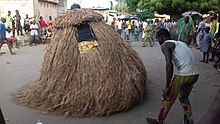

Portal maintenance status: (June 2018)
|
Welcome to the Traditional African religions portal
Introduction The beliefs and practices of African people are highly diverse, including various ethnic religions. Generally, these traditions are oral rather than scriptural and are passed down from one generation to another through folk tales, songs, and festivals, and include beliefs in spirits and higher and lower gods, sometimes including a supreme being, as well as the veneration of the dead, and use of magic and traditional African medicine. Most religions can be described as animistic with various polytheistic and pantheistic aspects. The role of humanity is generally seen as one of harmonizing nature with the supernatural. (Full article...) Refresh with new selections below (purge) Selected articleAfrican art describes the modern and historical paintings, sculptures, installations, and other visual culture from native or indigenous Africans and the African continent. The definition may also include the art of the native African, African diasporas, such as African American, Caribbean and other American art. Despite this diversity, there are some unifying artistic themes when considering the totality of the visual culture from the continent of Africa. Traditional African religions have been extremely influential on African art forms across the continent. African art often stems from the themes of religious symbolism, functionalism and utilitarianism, and many pieces of art are created for spiritual rather than purely creative purposes. Many African cultures emphasize the importance of ancestors as intermediaries between the living, the gods, and the supreme creator, and art is seen as a way to contact these spirits of ancestors. Art may also be used to depict gods, and is valued for its functional purposes. Selected images
Image 1An early 20th century Yoruba divination board.
Credit: Tamsier
Image 2Traditional healer of South Africa performing a divination by reading the bones.
Credit: User:FastilyClone (Fastily)
Image 3An early-20th-century Igbo medicine man in Nigeria, West Africa.
Credit: Ukabia
Image 4The star Yoonir, symbol of the Universe in Serer religion and Cosmogony. The peak of the star (top point) represents the Supreme Deity (Roog). The other four points represent the cardinal points of the Universe. The crossing of the lines ("bottom left" and "top right", and "top left" and "bottom right") pinpoints the axis of the Universe that all energies pass. The top point is "the point of departure and conclusion, the origin and the end". Among the Serers who cannot read or write the Latin alphabet, it is very common for them to sign official documents with the star of Yoonir, as the star also represents "good fortune and destiny". Yoonir also represents the Serer people and the Serer precolonial Kingdom of Sine.
Credits: Sarang, AnonMoos, (and Yoonir filebyTamsier)
Image 5The gods Osiris, Anubis and Horus, in order from left to right, painted inside the tomb of pharaoh Horemheb.
Credit: A. Parrot
Image 6Serer representation of the universe. The three worlds : the invisible world, the terrestrial world and the nocturnal world.
Credit: Henry Gravrand - La civilisation sereer : Pangool
Image 8The Senegambian stone circles (Wassu section) believed by archaeologists and historians to be built by the Serer people of the Senegambia region. The Senegambia stone circles are the largest concentration of stone circles seen anywhere in the world according to UNESCO. They are sacred burial grounds and a place of ritual offerings (kuurinSerer).
Credit: Atamari
Image 9AnIgbo Ukwu bronze ceremonial vessel made around the 9th century AD.
Credit: Ukabia
Image 10Vodun altar with several fetishes in Abomey, Benin (West Africa).
Credit: Dominik Schwarz
Image 11Bakongo masks from the Kongo Central. In traditional African religions, masks play an important part in many ritual ceremonies.
Credit: Ndoto ya Afrika FestivalsThere are several religious festivals found in the various Traditional African religions. Some of these are listed below next to their corresponding religion :
Selected biographyWritten sources augment the Mande oral histories, with the Moroccan traveller Muhammad ibn Battúta (1304–1368) and the Tunisian historian Abu Zayd 'Abd al-Rahman ibn Muhammad ibn Khaldun al-Hadrami (1332–1406) both having travelled to Mali in the century after Sundiata’s death, and providing independent verification of his existence. The semi-historical but legendary Epic of Sundiata by the Malinké/Maninka people centers on his life. The epic poem is primarily known through oral tradition, transmitted by generations of Maninka griots. Selected quote
Ram Swarup quoted in Koenraad Elst (2002)
Source: Swarup, Ram [in] Elst, Koenraad, Who is a Hindu? : Hindu Revivalist Views of Animism, Buddhism, Sikhism, and Other Offshoots of Hinduism, Voice of India (2002), p. 72, ISBN 9788185990743
Did you know
Related portalsTopics
For more Traditional African religion topics, see Category:Traditional African religions.
CategoriesWikiProjectsThings you can do
Associated WikimediaThe following Wikimedia Foundation sister projects provide more on this subject:
Commons
Wikibooks
Wikidata
Wikinews
Wikiquote
Wikisource
Wikiversity
Wiktionary
Discover Wikipedia using portals
| |||||||||||||||||||||||||||||||||||||||||||||||||||||||||||||||||||||||||||||||||||||||||||||||||||||||||||||||||||||||||||||||||||||||||